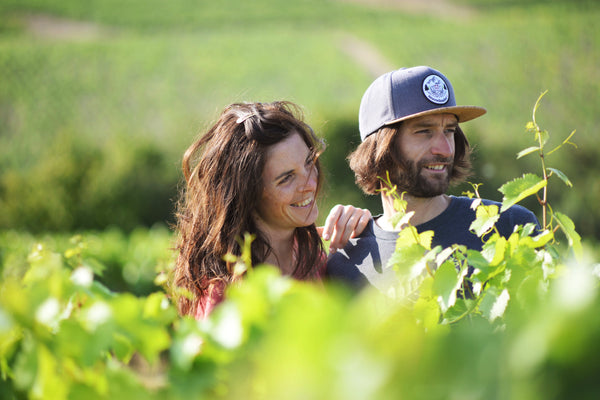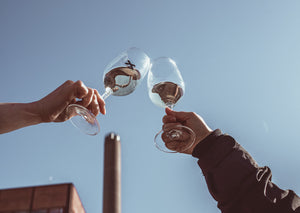
Eleni et Edouard Vocoret
German-Greek Eleni and Chablis native Edouard met in New Zealand, where they worked at Allan Scott Wines in Marlborough. Elen's Greek father was from a farming family whose repertoire also included winemaking, but only for the family's own use. The German mother, on the other hand, was from a completely different field, and when Eleni grew up in Germany, wine was not part of her youth. The Edouard family, on the other hand, is known for its large winery in the town of Chablis. Elen was originally supposed to head from New Zealand to Greece to run a winery with her brother, Christos Christian Theodoropoulos. However, in order to understand how to sell wine, Eleni also wanted to learn winemaking, so she accepted a winemaking internship in Austria. During the trip, he noticed how making wine was much more interesting than selling it. Together with their brother, they decided that the success of a wine project in Greece might be too challenging. Thus, Christos moved to Mittelrhein to run Weingut Lithos and Eleni ended up moving to Edouard's home in the village of Chablis in 2010 after traveling.
The couple received 5 hectares of vineyards from Édouard's father, Patrice, at the end of 2012, but the father did not give much advice on winemaking. It was clear from the beginning that the young people should make exactly the kind of wine they wanted. Edouard had worked with Daniel Barraud in Maconnais, and inspired by Daniel's working methods, he wanted to make his own wines in a different way than the Vocoret family had done. The couple wanted stoniness, saltiness and acidity in their wines, and to balance these, they chose to use old oak barrels instead of the steel tanks that are standard practice in the region. The couple took advantage of Edouard's grandfather's small garage, where they made their first wines. Father Patrice and Vincent Dauvissat, whose winemaker's assistant Eleni worked for, helped the couple get started. It was immediately clear that the couple's wines would be made with natural yeast strains and vineyards would be plowed instead of weed poisoned to maximize their expressiveness. The grapes in the vineyards are picked by hand and when they arrive at the farms, the grapes are compressed pneumatically. Both alcoholic and malolactic fermentation takes place in steel tanks, after which the wines are transferred by gravity to old barrels to mature for a year. The youngest of the barrels is 5 years old and the oldest is Edouard's age, from 1986.
Although the farm is only barely 10 years old, with the first vintage released in 2013, it has become one of the most celebrated names among Chablis artisan producers. The estate produces four different wines, as the couple wants to vinify each of their village-level vineyards separately. Butteaux's 1er Cru vineyard is probably familiar to all Chablis fans as one of the subplots of Montmains 1er Cru. The Vocoret portion of the estate is located right next to Les Forêts, covers 0,3 hectares, and was planted in 1956. The lieux-dit portion of the Bas de Chapelot's deep Calcareous and loamy 3 hectares lies, as its name suggests, in the Montée de Tonnerre 1er Cru' below the Chapelot plot belonging to n on the right bank of the village. En Boucheran is an east-facing valley between the 1er Cru vineyards of Vaillons and Montmains. The clay style of the area can be divided into three different parts. One part of the valley is an old quarry, so there are a lot of holes in the ground due to earth moving. The clay in the second part is sticky and would be good for clay casting. 30-40 cm below the clay there are plenty of oyster shells, telling about the area's past as a seabed. The third part is flat land, where the ground is also deeper. The lieux-dit plot of Les Pargues is located on the left bank of the Serein river, southeast of Montmains. Other farmers on the plot include Servin, Moreau-Naudet and Romain Collet. Although the distance between En Boucheran and Les Pargues is only 500 meters and the wines are made in the same way, they are remarkably different. The soil of Les Pargues is a white calcareous clay that makes the wine Boucheran more linear.
Village-level nurseries were planted in the 1980s and 1990s. Logistically, it is easy that the shelter areas are all located in the village of Chablis. However, the growing conditions cause considerable challenges, because in the fall of 2015, a local hailstorm that hit the village destroyed almost all the grapes just before the harvest. So far, the farm's wines are not organically certified, but the farms are working with the aim of organicity.
The farm's total annual production is around 37,000 bottles.
http://vocoret.fr/
Come and join us in creating a better wine culture
We at Viinitie believe that Finland is ready for a better wine culture. People are thirsty for quality, responsibility and stories in more and more glasses. That's why we want to be even more torchbearers of this cultural change and make better wines available to everyone.
Join the Viinitie Grand Crew community and you are involved in making a better wine culture.
Powered by Shopify © 2025, Viinitie Oy

